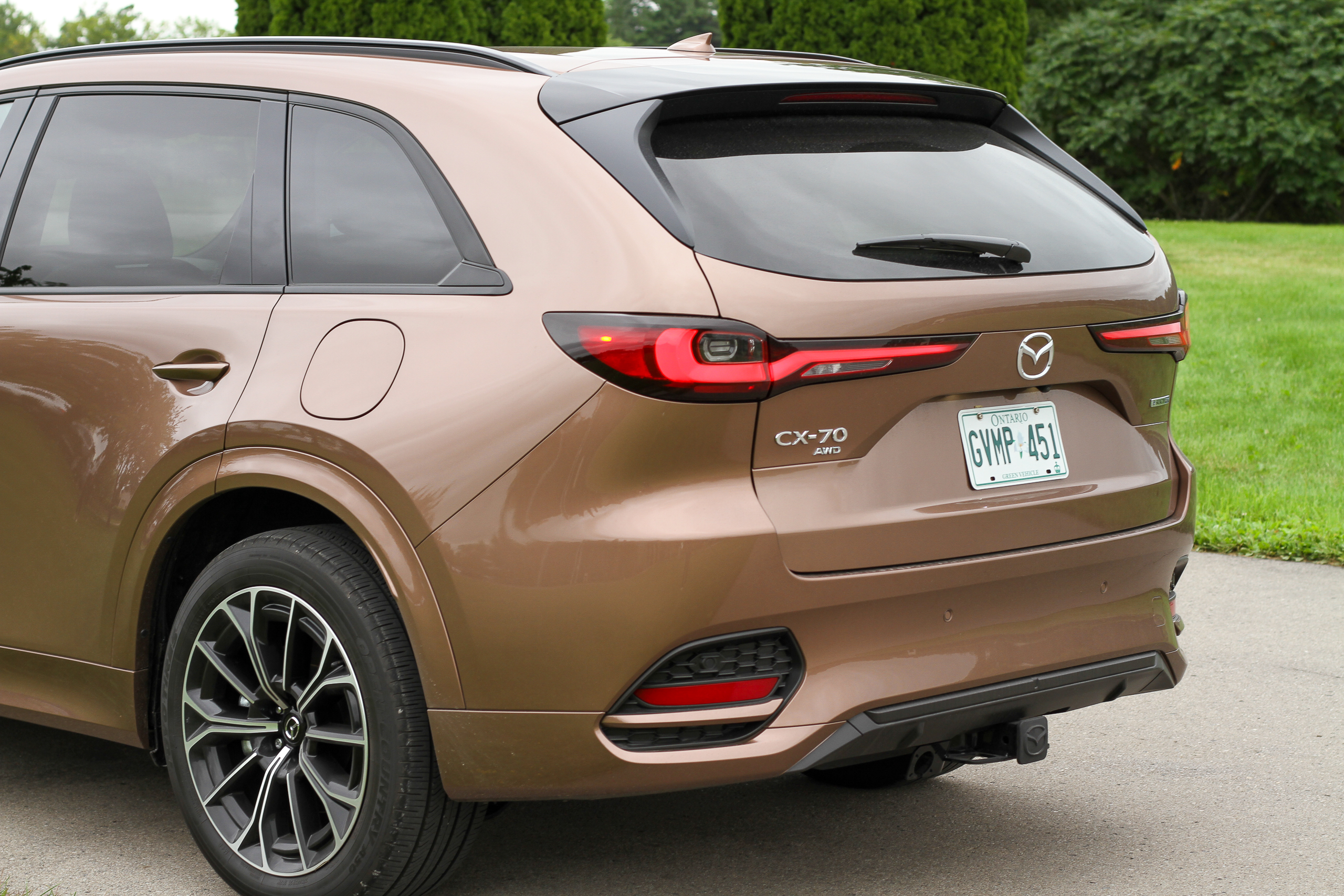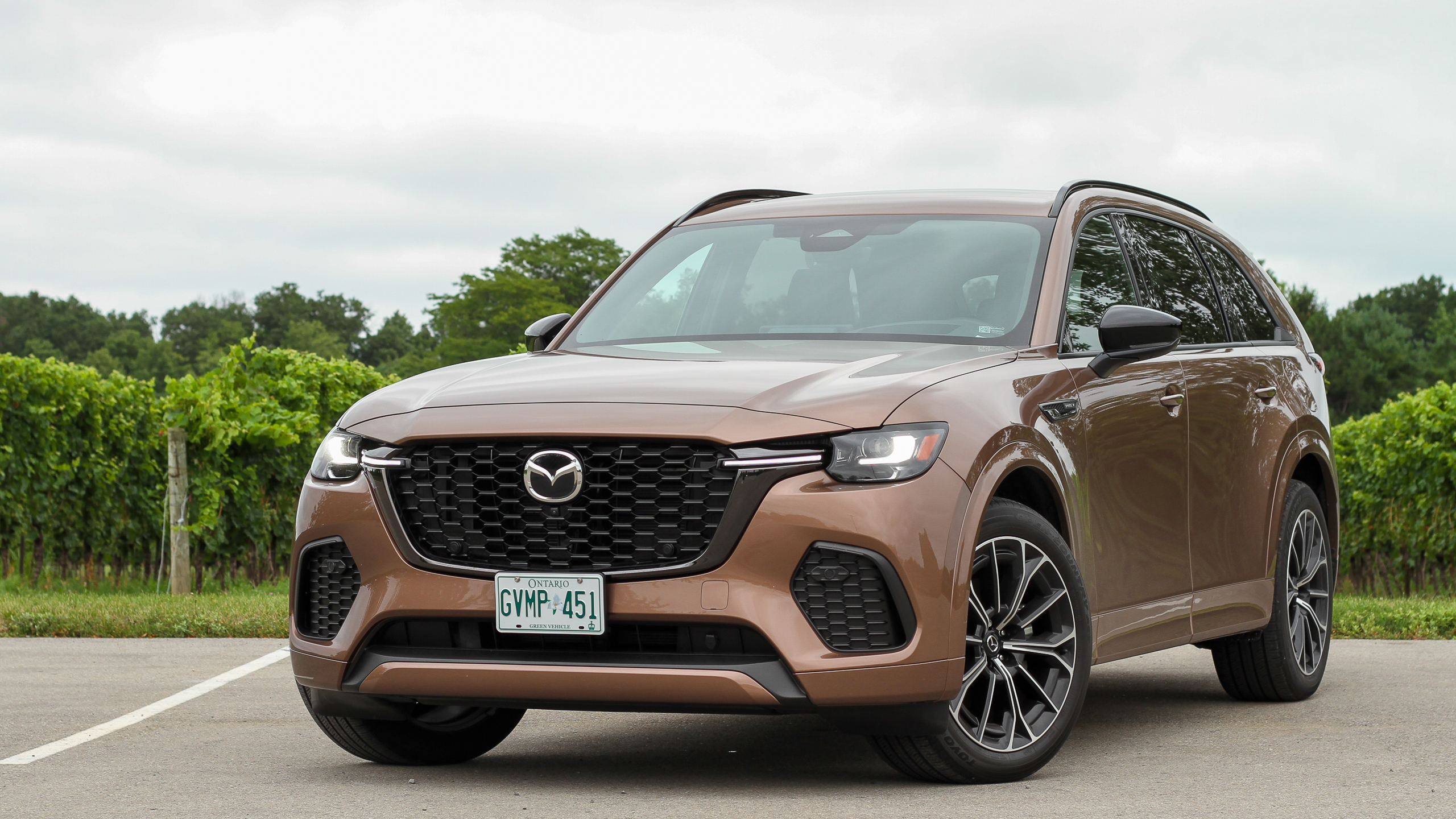We may earn revenue from the products available on this page and participate in affiliate programs. Learn more ›
The 2025 Mazda CX-70 is just a CX-90 with the third row of seats removed.
It looks like a CX-90 on the outside, it looks like a CX-90 on the inside, and it feels like a CX-90 from behind the wheel. For this review, I snagged a plug-in hybrid version mostly because we’ve already driven the more powerful straight-six setup when we reviewed the CX-90. Because, you see, they are effectively the same car.
Hence, the verdict is largely the same. Much like the CX-90, the Mazda CX-70 is an attractively styled, spacious, and relatively fun-to-drive family crossover that could use some work at actually being a family crossover.



The Basics
Alongside the CX-90, the CX-70 is the largest vehicle in Mazda’s lineup. Par for the Mazda course, it’s among the most sensuously styled products in its segment. A long hood, cab-back proportions, luxury-car surfacing, and interesting paint options mark it out as a family SUV you buy with both your heart and your mind.




This oddly stylish attitude carries on inside where you find a cabin that would befit a full-on luxury car from not that long ago. From a usability standpoint, it’s actually superior to many modern luxury cars with climate controls that still get their own row of dedicated buttons and a gear selector that’s simple to operate.
This being a Mazda, the infotainment system isn’t a touchscreen, but the knob controller is one of the better physical screen input devices out there and the software is clean-looking and simple to navigate. The knob is perfectly fine 90% of the time, although I wish the screen was touch-sensitive as a redundancy for the remaining 10% when I’d like to quickly zoom in on a map or something.
The seats front and rear are unobtrusively comfy, and there’s a generous amount of room on account of the car in general being huge. Although, I wish the cabin had more storage nooks and cubbies.




Driving the Mazda CX-70 PHEV
Setting off, the Mazda CX-70’s plug-in hybrid powertrain does not make a great first impression. It’s remarkably not-smooth for a car of this type, especially at low, parking lot speeds. The hybrid powertrain can be jerky as it tries to juggle both electric and gas propulsion. Once, the gas engine (a 2.5-liter four-cylinder) fired up abruptly as I was slowly turning left at an intersection, causing a big, unsettling lurch.
Some of this may actually be a deliberate design choice. It uses an eight-speed automatic transmission, but instead of a regular torque converter, the CX-70 uses “strategically placed clutches” that deliver “crisp and defined shifts much like a manual transmission.” An automatic gearbox that shifts with a kick may be cool in, like, a V12 Lambo, but in a big Mazda SUV that buyers may or may not be buying to chauffeur children and/or the elderly, it’s not nearly as cool.

Locking the car in EV Mode helps (provided you’ve plugged in and have enough range to do so), but even then the electric motor feels like it is shifting through gears as it accelerates, something I have to assume is artificial to appease the supposed car nuts this thing is targeting. The CX-70 is, however, available with a more conventional 3.3-liter straight-six and, on driving characteristics alone, that’s the one to get, although that comes at the sacrifice of the hybrid’s naturally superior fuel economy (more on that later).
Movements in everyday driving outside of the powertrain could also use work. Low-speed steering is weirdly heavy, feeling almost like the tires are stuck to the road but not in a good way. The ride isn’t great, either. For a vehicle that’s ultimately made to ferry four maybe even five adults in great space and comfort, the CX-70 exhibits a lot of vertical movement over bumps.
The Highs and Lows
This car’s big strength, however, is the way it corners at medium to high speeds. Pretty much all of Mazda’s cars are the athletes in their respective segments and the CX-70 is no different. Put it in sport mode and the gauges go red, the powertrain is on max attack, and the thing steers and moves with a level of deliberate precision that would put many base-level German luxury SUVs to shame. It’s really quite enjoyable.




But a lot of the time, I wish it was better at just being a regular-ass family crossover. I wish it was smoother in parking lots and had more places to put stuff. I wish there wasn’t a rattle near the passenger front door and I wish the driver’s door didn’t creak subtly when it opened or closed.
So, it’s a decent driving machine that makes you pay for it. But who shopping in this particular segment is actually looking for that? It’s very nice looking and the interior is cleaner and classier than the competition, but taking it on a short road trip, I found myself wishing I was in a Toyota Grand Highlander or something instead. And for what it’s worth, many of the competing SUVs have come a long way in the Being A Nice Car department too, with the Hyundai Palisade and Kia Telluride arguably leading the charge.

Fuel Economy
Speaking of charge, the plug-in hybrid Mazda CX-70 is rated by the EPA to get 25 combined mpg with the gas engine or 56 mpge using both gas and electric. Using just the latter, it can travel 26 miles thanks to a 17.8-kWh battery. For reference, the Toyota RAV4 Prime goes 42 miles on a charge, matching the distance the average American travels on any given day, per this report. Meaning if you’re an average American with an average commute who can charge the CX-70 PHEV at home nightly, the plug-in Mazda can meet your needs without using any gas so long as you can charge it at the office, too.
Over almost 370 test miles involving two full batteries (i.e. I picked this car up with a full battery and plugged it in overnight once while I had it), I observed 29 mpg.
Mazda CX-70 Features, Options, and Competition
The 2025 Mazda CX-70 as a whole starts at $41,900 for a straight-six Preferred, but the PHEV starts at $55,855 for a Premium. Trims being equal, the PHEV commands $8,500 more than the 3.3T. If you ask me, the straight-six is easily the more polished powertrain and more worthy of your money. You’ll lose out on the plug-in’s fuel savings but the lower price of entry should offset that, at least for a little while.

If you do go for the CX-70 PHEV, though, it comes pretty well-equipped with standard 21-inch wheels, heated mirrors, a pano roof, three-zone climate, radar cruise control that works quite well, leather, heated front seats, and 12 Bose speakers. Shell out an extra $3,050 for the Premium Plus and you get a wiper de-icer, auto-dimming and power-folding side mirrors, a 150-watt accessory outlet, LED illuminated front footwells, Nappa leather available in red, a heated second row, a ventilated first row, a heated steering wheel, and a few extra active safety gizmos.
The CX-70 finds itself in a somewhat weird spot in relation to competitors since it’s physically the same size as stuff like the Toyota Grand Highlander, Honda Pilot, and Chevy Traverse but only comes with two rows of seats. Mazda’s entry is more fun to drive and subjectively nicer to look at, but isn’t as practically minded or well-built as most of its rivals. The Hyundai Palisade and Kia Telluride are also worth closer looks but are V6-only—alongside the Kia Sorento, the CX-70 stands out as one of the only cars in its general domain to be offered as a plug-in hybrid, for now.
Value and Verdict
The 2025 Mazda CX-70 reminds me of a cut-price Alfa Romeo. In line with the brand’s reputation, it really does handle better than its competitors when faced with a twisty road. But that fun comes at the cost of other, more practical considerations. You’ll find more interior room, better build quality, comfier rides, and more robust powertrains elsewhere.


But even if you’ve bought into the Mazda Way, I’m confused as to why one would go for a CX-70 rather than just getting a CX-90 and keeping the rear seats folded down. Y’know, that “rather have ’em and not need them” sorta deal. Trims being equal, the CX-90 PHEV costs just $500 more and if you’re really value-conscious, you can even have the 90 in a cheaper, more basic Preferred trim that actually undercuts the base 70 by about six grand. There is no Preferred trim for the CX-70 PHEV. And if you thought perhaps the CX-70 has a bigger behind-second-row cargo area on account of not having to accommodate a third row at all, its 39.6 cubic feet is actually smaller than the CX-90’s 40.0 cubic feet with the third row folded.
Mazda may want us to treat the CX-70 as its own thing, but in reality, it’s simply a CX-90 with a hypothetical “third row delete” option box ticked. And if that’s what you want, here it is, I guess. Get it with the straight-six powertrain and it isn’t even a bad car.

But that still doesn’t answer the question: Why was the CX-70 billed as its own model? Mazda would likely never admit to this, but my theory is that there is some system-gaming bureaucratic reason. Does calling this a CX-70 let Mazda count it as a whole additional PHEV on its CAFE quotas? Is someone on high mandating Mazda sell exactly five (5) “distinct” models of SUV when it really only has the budget to develop four? When Car and Driver raised the question directly, Mazda’s cagey response suggested that the CX-70’s existence may be a simple SEO play—and as an online media professional in 2024, I can’t say I don’t respect that.
The real, unfiltered answer feels like something we’ll only get years from now when some Mazda product planner retires and their NDA expires. But for now, the CX-70 PHEV is one of those weird, automotive anomalies: a hybrid that isn’t as smooth as its gas counterpart, and a Mazda product that, for once, isn’t quite a slam dunk.
| 2025 Mazda CX-70 PHEV Specs | |
|---|---|
| Base Price (Canadian-spec as tested) | $55,855 ($65,845 CAD) |
| Powertrain | 2.5-liter four-cylinder with plug-in hybrid electric motor | 8-speed automatic | all-wheel drive | 17.8-kWh battery |
| Horsepower | 323 @ 6,000 rpm (total) 189 @ 6,000 rpm (gas) 173 @ 5,500 rpm (electric) |
| Torque | 369 lb-ft @ 4,000 rpm (total) 192 lb-ft @ 4,000 rpm (gas) 199 lb-ft @ 400 rpm (electric) |
| Seating Capacity | 5 |
| Cargo Volume | 39.6 cubic feet behind second row | 75.3 cubic feet behind first row |
| Curb Weight | 5,198 pounds |
| Ground Clearance | 8.1 inches |
| EPA Fuel Economy | 25 mpg combined (gas) | 56 mpge (gas and electric) |
| Electric Range | 26 miles |
| Quick Take | The CX-70 PHEV is fun to hoon, nice to look at, and good on gas, but as a family runabout, it’s oddly executed and oddly positioned in Mazda’s own lineup. |
| Score | 7/10 |









Got a tip or question for the author about the CX-70? You can reach him here: chris.tsui@thedrive.com

